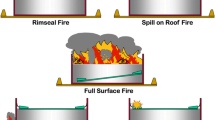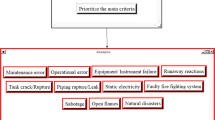Abstract
Atmospheric storage tank fires are relatively rare, but because of storing large amount of flammable liquid in them, they have catastrophic consequences. This study presents a review of atmospheric storage tank fire scenarios causes and costs. The fire accidents on the atmospheric storage tanks were collected from accident databases, papers and other sources. The causes and costs of the 104 accidents were classified. Initiating event of 38% of the accidents was environmental factors, 20% was equipment factors, 15% was operation factors (human error), 13% was domino effect, 10% was maintenance factor and 4% was terrorist attack. Lightning strikes were the most frequent cause of the accidents triggered by the environmental factors (21.73%). The cost of accidents that have produced domino effects was eight times more than cost of accidents without domino effects. The average cost for accidents that have produced domino effects was approximately 24,181,673$, and for accidents without domino effects, it was 205,191,298$. Identification of storage tank accident causes and cost can provide insights into how managers make cost–benefit analysis and implement effective corrective actions and safety barriers.






Similar content being viewed by others
References
International Association of Oil & Gas Producers (OGP), Risk Assessment Data Directory. Report No. 434-3 (2010)
I. Board, The Buncefield Incident (2005)
K.B. Mishra, K.D. Wehrstedt, H. Krebs, Lessons learned from recent fuel storage fires. Fuel Process Technol. 107, 166–172 (2013). https://doi.org/10.1016/j.fuproc.2012.08.003
M. Girdhar, Jaipur Fire and its Environmental effects, in 12th ESRI India User Conference (2011)
S.T. Explosion, Fire in Glenpool, Oklahoma April 7, 2003. NTSB/PAR-04/02, PB2004-916502, Notation 7666. National Transportation Safety Board
J.I. Chang, C.C. Lin, A study of storage tank accidents. J. Loss Prev. Process Ind. 19(1), 51–59 (2006)
B. Zheng, G.H. Chen, Storage tank fire accidents. Process Saf. Prog. 30(3), 291–293 (2011)
National Fire Protection Association. NFPA 30: Flammable and Combustible Liquids Code: NFPA 30A: Code for Motor Fuel Dispensing Facilities and Repair Garages. The Association (2000)
API standard 650: Welded steel tanks for oil storage. American Petroleum Institute (2007)
API standard 620: Design and Construction of Large, Welded, Low-Pressure storage tanks (2012)
USCSB. Monthly incident news reports. US Chemical Safety and Hazard Investigation Board, Washington, DC. (2018)
MARS website:. http://mahbsrv.jrc.it/Activities-WhatIsMars.html
ARIA website: https://www.aria.developpement-durable.gouv.fr/the-barpi/the-aria-database/?lang=en
JST website: http://www.sozogaku.com/fkd/en/
H. Persson, A. Lönnermark, Tank Fires-Review of fire incidents 1951–2003 (2004)
Y. Riezel, Explosion and fire in a gas-oil fixed roof storage tank: case study and lessons learned. Process Saf. Prog. 21(1), 67–73 (2002)
Marsh. The 100 largest losses 1978–2017—large property damage losses in the hydrocarbon industry. Technical report, Marsh Global Energy Risk Engineering. Available at https://www.marsh.com/us/insights/research/100-largest-losses-in-the-hydrocarbon-industry.html (2018)
T. Kletz, Learning from Accidents (Routledge, Abingdon, 2007)
F.P. Lees, Loss Prevention in the Process Industries (Butterworth, Oxford, 1996)
C. Crippa, L. Fiorentini, V. Rossini, R. Stefanelli, S. Tafaro, M. Marchi, Fire risk management system for safe operation of large atmospheric storage tanks. J. Loss Prev. Process Ind. 22(5), 574–578 (2009)
Funding
This work is part of the first author PhD thesis supported by the Tarbiat Modares University.
Author information
Authors and Affiliations
Corresponding author
Ethics declarations
Conflict of interest
No potential conflict of interest was reported by the authors.
Additional information
Publisher's Note
Springer Nature remains neutral with regard to jurisdictional claims in published maps and institutional affiliations.
Rights and permissions
About this article
Cite this article
Ahmadi, O., Mortazavi, S.B. & Mahabadi, H.A. Review of Atmospheric Storage Tank Fire Scenarios: Costs and Causes. J Fail. Anal. and Preven. 20, 384–405 (2020). https://doi.org/10.1007/s11668-020-00846-5
Received:
Revised:
Published:
Issue Date:
DOI: https://doi.org/10.1007/s11668-020-00846-5




